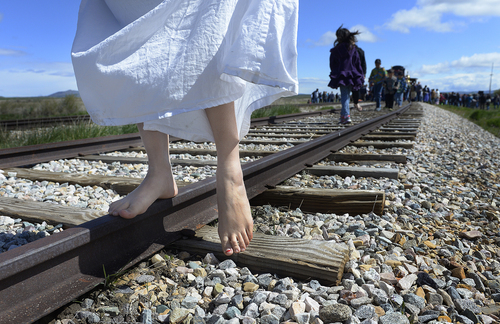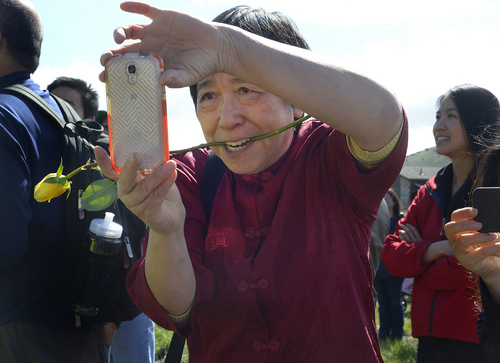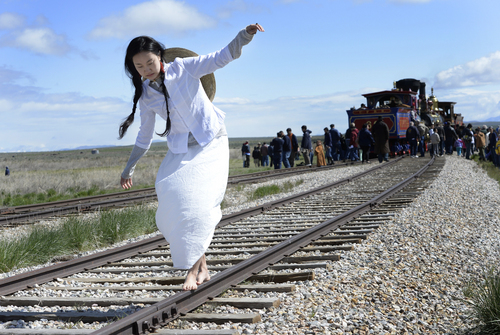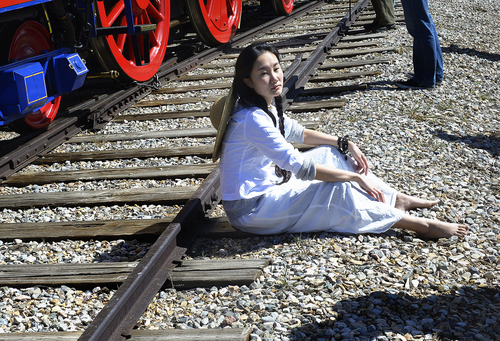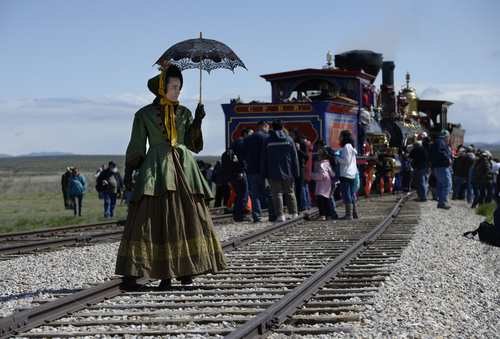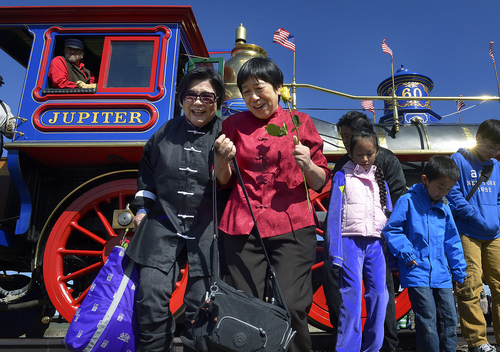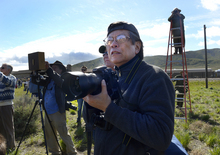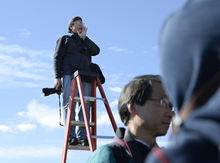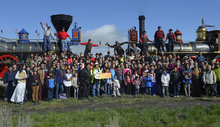This is an archived article that was published on sltrib.com in 2014, and information in the article may be outdated. It is provided only for personal research purposes and may not be reprinted.
Promontory Summit • In what an organizer called a "photographic act of justice," some 200 Chinese Americans, Chinese citizens and other Asian American friends posed here Saturday on the 145th anniversary of the completion of the Transcontinental Railroad.
They were going for an iconic photo of their own, one to match the "champagne" photograph that has come to symbolize the celebration that day long ago when the Central Pacific from the West and Union Pacific from the East met on the windswept desert north of the Great Salt Lake.
The meeting of the rails on May 10, 1869, after nearly five deadly, costly years linked together the industrial East and the resource-rich West for the first time. A journey that previously took six months by ox-drawn wagon was reduced to six days. The most famous photograph from that day shows hundreds of railroad employees, executives and other celebrators — but none of the more than 11,000 Chinese workers who laid track over the Sierra Nevada, across the desert and into Utah. The Chinese workers' contribution, said New York City photographer Corky Lee, is "a neglected and forgotten," piece of American history.
Saturday's visit and photograph, he said, "is as an act of photographic justice." The photographer worked with a Utah-based coalition, the Chinese Transcontinental Railroad Commemoration Project, to bring the group together on Saturday. He had the 200, including visitors from China's Guandong Province, pose in front of the replica locomotives, as he did when a similar group came to the anniversary celebration in 2002.
The group also walked to Chinese Arch, a limestone span several miles from the Golden Spike National Historic Site's visitor center.
Two of those participating Saturday, brother and sister Michael and Karen Kwan, in 2005 successfully petitioned the U.S. Board on Geographic Names to change the arch's name from Chinaman's Arch. Their great-great-great grandfather worked on the Transcontinental Railroad.
Margaret Yee, whose great-great grandfather was a chef for the Chinese work crews, said she felt the presence of the laborers as she and a New York dancer and actress, Wan Zhao, walked together along the rail.
"We came to pay them respect," said Yee, a former head of Asian American affairs for two Utah governors. "One-hundred-forty-five years ago, nobody recognized them."
Zhao, an immigrant from Mongolia, has been immersing herself in the history of the Chinese workers and immigrants, and performed a dance of prayer Saturday on the rails.
It's a bit of sore spot for some in the Chinese American community that they had never been invited to help reenact the driving of the rails.
Norm Nelson, the president of the Golden Spike Association, said members of the Chinese community have long been involved in other parts of the celebration, including the act of laying a wreath on the rails to remember those who died working on the railroad.
But they have not been invited to re-enact the placement of the last spikes. "They weren't part of that [original] ceremony," Nelson, of Perry, said.
Lee, however, notes that women also were not part of the original ceremony, although some were present that day in 1869. He notes there are no women in the iconic champagne photo, although women and children in costume are always included in the re-enactment photos.
On Saturday, after Lee took photos of the Chinese American group, those in period costume were photographed.
And then the two groups and hundreds of other celebration attendees were photographed together.
Ze Min Xiao, the main organizer of Saturday's visit to Golden Spike, said the coalition wants to steadily increase the number of Asians who participate each year.
It also wants more recognition from political leaders, to create a supplemental curriculum for Utah classrooms, and to archive the oral history stories of Asian Americans.
It's interesting, she said, that the descendants of the Chinese laborers, who were forced to return to China by American law, later immigrated to the United States.
Karen Kwan, who teaches psychology at Salt Lake Community College and is running for the state House, said the railroad workers' contributions deserve a more prominent place in Utah's historical consciousness.
"Utah was built by a great diversity of people. We belong to Utah. Utah belongs to us."
kmoulton@sltrib.com
Twitter: @KristenMoulton —
U.S. Labor Department honors workers
P U.S. Labor Secretary Tom Perez on Friday inducted the Chinese railroad workers who helped build the Transcontinental Railroad into the Department of Labor's Hall of Honor.


